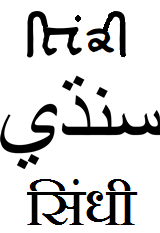Language/Sindhi/Vocabulary/Greetings-and-Introductions
| ◀️ Basic Consonants and Vowels — Previous Lesson | Next Lesson — Numbers and Counting ▶️ |
Introduction[edit | edit source]
Welcome to the lesson on Greetings and Introductions in Sindhi! In this lesson, we will learn common greetings and introductions in Sindhi, including how to introduce yourself and others. Greetings and introductions are essential in any language as they help create a positive and friendly atmosphere. By mastering these phrases, you will be able to start conversations and make connections with Sindhi speakers. So, let's begin!
Basic Greetings[edit | edit source]
Let's start with some basic greetings that you can use to say hello and goodbye in Sindhi.
Saying Hello[edit | edit source]
In Sindhi, there are different ways to greet someone depending on the time of the day and the level of formality. Here are some common ways to say hello in Sindhi:
| Sindhi | Pronunciation | English Translation |
|---|---|---|
| سُهَاڻوَءُ | suhāṇwā̄ | Good morning |
| سَباهُ ٿُو | sabāhu ṭū | Good morning (informal) |
| شَبهُ بَخَيْرُ | shabahu bakhaīru | Good evening |
| عَسَلَمَالِيڪُم | asalamālīkuṃ | Peace be upon you (formal) |
| تُهَانَُوَڪَ | tuhānawā̄ka | Hello (informal) |
Saying Goodbye[edit | edit source]
Just like greetings, there are different ways to say goodbye in Sindhi. Here are some common phrases:
| Sindhi | Pronunciation | English Translation |
|---|---|---|
| الوِداعُ | alwidāʿu | Goodbye |
| الوِداعُ (آڄو) | alwidāʿu (ājū) | Goodbye (informal) |
| اللهَ مَانِڪُ | allāha māniku | God be with you (formal) |
| چَلوْ | calō | Bye (informal) |
Introducing Yourself[edit | edit source]
Now that you know how to greet someone in Sindhi, let's learn how to introduce yourself. When introducing yourself, it is common to state your name and ask the other person's name. Here's an example conversation:
A: سُهَاڻوَءُ، مُنيڪُنَہُرُون ڇُڏُنَدُو? B: سُهَاڻوَءُ، مُني سُبَيھُمَا ڇُڏُنَدُو. تُهَانِ جي نالُو ڇُڏَنَدَہُ؟ A: مُنيڪُنَہُرُون ڇُڏَنَدَہُ.
Translation: A: Good morning, what is your name? B: Good morning, my name is Subhama. What is your name? A: My name is Kunahuroon.
In Sindhi, the phrase "مُنيڪُنَہُرُون ڇُڏُنَدُو?" (What is your name?) is commonly used to ask someone's name. You can replace "مُنيڪُنَہُرُون" (my name) with your own name when introducing yourself.
Introducing Others[edit | edit source]
Apart from introducing yourself, it is also important to know how to introduce others in Sindhi. Let's look at an example conversation:
A: سُهَاڻوَءُ، هيڪَانُ ٿُو؟ B: سُهَاڻوَءُ، هوَ ڇُڏُنَدُو. تُهَانِ جي نالُو ڇُڏَنَدَہُ؟ A: هوَ مُنيڪُنَہُرُون ڇُڏَنَدَہُ. C: سُهَاڻوَءُ، مُني عَلِيصَا ڇُڏُنَدَہُ.
Translation: A: Good morning, who is this? B: Good morning, he is my friend. What is your name? A: His name is Kunahuroon. C: Good morning, my name is Alisa.
In Sindhi, the phrase "هيڪَانُ ٿُو؟" (Who is this?) is commonly used to ask about someone's identity. You can replace "هوَ" (he) with the person's name or relationship when introducing them to someone else.
Cultural Insights[edit | edit source]
Sindhi culture places great importance on greetings and introductions. When greeting someone, it is customary to use honorific titles and show respect. In formal settings, such as business meetings or religious gatherings, people often greet each other with the phrase "عَسَلَمَالِيڪُم" (Peace be upon you). This greeting is also used as a sign of respect to elders and people of higher social status. In informal settings, friends and family members often greet each other with the phrase "سَباهُ ٿُو" (Good morning).
In Sindhi culture, it is common for people to introduce themselves by stating their full name along with their father's name. This tradition reflects the importance of family and lineage in Sindhi society. It is also customary to exchange pleasantries and inquire about each other's well-being during introductions. This shows genuine interest and care for the other person. Remember to reciprocate these gestures when interacting with Sindhi speakers to show respect and build rapport.
Practice Exercises[edit | edit source]
Now it's time to practice what you've learned! Complete the following exercises to reinforce your understanding of greetings and introductions in Sindhi.
Exercise 1: Match the Greetings Match the Sindhi greetings on the left with their English translations on the right.
| Sindhi | English Translation |
|---|---|
| سُهَاڻوَءُ | Good morning |
| شَبهُ بَخَيْرُ | Good evening |
| الوِداعُ | Goodbye |
| عَسَلَمَالِيڪُم | Peace be upon you |
Solution:
| Sindhi | English Translation |
|---|---|
| سُهَاڻوَءُ | Good morning |
| شَبهُ بَخَيْرُ | Good evening |
| الوِداعُ | Goodbye |
| عَسَلَمَالِيڪُم | Peace be upon you |
Exercise 2: Fill in the Blanks Fill in the blanks with the appropriate Sindhi phrases.
1. سُهَاڻوَءُ، مُني _______ ڇُڏُنَدُو. 2. _______ (آڄو)، مُني سُبَيھُمَا ڇُڏُنَدُو. 3. الوِداعُ (آڄو)، _______ ڇُڏُنَدُو. 4. هيڪَانُ ٿُو؟ 5. سُهَاڻوَءُ، هوَ _______ ڇُڏُنَدُو.
Solution: 1. سُهَاڻوَءُ، مُني سُبَيھُمَا ڇُڏُنَدُو. 2. الوِداعُ (آڄو)، مُني سُبَيھُمَا ڇُڏُنَدُو. 3. الوِداعُ (آڄو)، سُهَاڻوَءُ ڇُڏُنَدُو. 4. هيڪَانُ ٿُو؟ 5. سُهَاڻوَءُ، هوَ مُني ڇُڏُنَدُو.
Conclusion[edit | edit source]
Congratulations! You have learned common greetings and introductions in Sindhi. By practicing these phrases, you will be able to start conversations and make connections with Sindhi speakers. Remember to use the appropriate greeting based on the time of the day and the level of formality. Keep practicing and building your vocabulary to become more proficient in Sindhi. Well done!
Sources[edit | edit source]
Other Lessons[edit | edit source]
- Cuisine
- How to Say Hello and Greetings
- Colors
- Days of the Week and Months
- At Work
- Counting
- History and Landmarks
- Travel and Transportation
- Clothes
- Count to 10
| ◀️ Basic Consonants and Vowels — Previous Lesson | Next Lesson — Numbers and Counting ▶️ |

